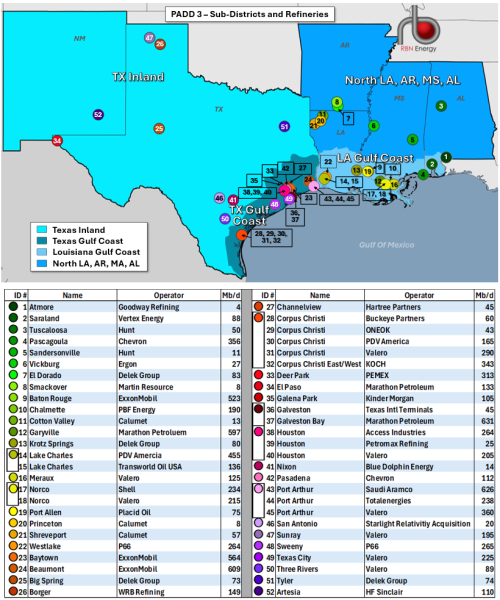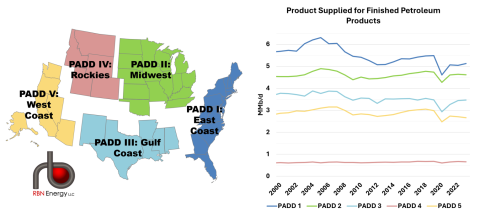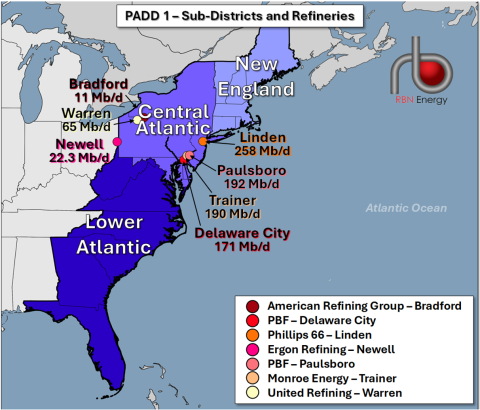Locator: 48423B.
Monday, February 24, 2025
A Petro-Hunt Charlson Well Hits 2.0 Million Bbls Crude Oil Cumulative -- February 24, 2025
Locator: 48422B.
Back on December 10, 2022, I suggested one of these wells might be the first Bakken well to hit 2 million bbls of oil cumulative and the spacing is only one section:
Locator: 10010USA2D.
The two wells:
The first well: noteworthy that it may be the first Bakken well to hit two million bbls crude oil cumulative.
- 16059, 729, Petro-Hunt, USA 2D-3-1H, Charlson field, single section, t10/06; cum 1.870044 million bbls 10/21; still producing 6,000 bbls/month, 11/19; update at this post; off line 5/20; remains off line 6/20; two days in 7/20; to be lengthened; confidential noted 11/20; still confidential but now producing again after being lengthened; update here; update here; cum 1.870044 million bbls 10/21; re-entry; cum 1.945212 million bbls 5/22; cum 1.966330 million bbls 10/22; cum 2.020875 million bbls 12/24;
- 16424, 700, Petro-Hunt, USA 11B-2-2H, Charlson, single section, t7/07; cum 673K 4/20; off line 5/20; remains off line 12/20; two days in 7/20; significant decline beginning 4/20; cum 805K 10/21; see this post; cum 1.002055 million bbls 5/22; see recent production here; cum 1.105512 millioon bbls 10/22; producing 20,000 bbls/month; 1.311227 million bbls 12/24; now producing 5,000 bbls oil per month;
The map:
WTI Holds At $72; One Permit -- Monday, February 24, 2025
Locator: 48421B.
Wow, a great day. The forecast was for 71° and it hit a high of 73°. Sunny and no wind. Whoo-hoo! Spring is here, the best time of the year, here in north Texas.
The NASDAQ pulled back today and I had one of my better days in the market.
I may say something about Apple later, but wow, BRK was incredible. I remember two years ago, or was it last year, that GEICO was struggling and now it's had a great turnaround. That GEICO gecko can take all the credit. It was also noteworthy that BRK had minimal losses due to fires in California. Pretty amazing. Ticker BRK-B was up almost 5%; up almost $20; and traded at a 52-week high. This was not on my bingo card today.
Okay, back to the Bakken.
Transfer Energy vs Greenpeace: finally in court. DAPL. Link to NYT. I probably won't follow the court action or post updates unless major updates. There's been a lot of talk that Greenpeace could lose this case. My hunch: framed as a "free speech" case, Greenpeace will prevail.
Greenpeace went on trial on Monday in North Dakota in a bombshell lawsuit that, if successful, could bankrupt the storied group.
The Dallas-based company Energy Transfer sued Greenpeace in 2017, accusing it of masterminding raucous protests over the construction of the Dakota Access Pipeline near the Standing Rock Sioux Reservation nearly a decade ago. The activists say the lawsuit is a thinly veiled tactic to suppress free speech and set a chilling precedent for protest groups, and that Greenpeace played only a supporting role in demonstrations that were led by Native Americans.
“This trial is a critical test of the future of the First Amendment, both freedom of speech and peaceful protest under the Trump administration and beyond,” Greenpeace’s interim director, Sushma Raman, said in public remarks on Thursday.
Energy Transfer declined to comment in advance of the trial. In a statement in August, it said the lawsuit against Greenpeace was “not about free speech as they are trying to claim. It is about them not following the law.”
******************************
End-Of-Day Report
WTI: $70.99.
Active rigs: 31.
One new permit, #41641:
- Operator: Grayson Mill
- Field: Camp, McKenzie
- Comments:
- Grayson Mill has a permit for a Marvin well, SEW 22-152-101,
- to be sited 620 FSL and 1829 FWL.
The Buzz -- February 24, 2025
The buzz -- headline and some links. It doesn't take a weatherman to know which way the wind is blowing.
Joann: to shutter all 800 locations; unable to find a buyer.
Jamie Dimon: supports Elon Musk and DOGE.
TCM: All The President's Men -- must watch. In current context of national politics.
BRK: not on my bingo card today -- BRK-B up 5% today; up $24 / share. Much could be said.
North Dakota connection: The Secret Service agent who leaped onto the back of President John F. Kennedy's limousine after the president was shot has died. North Dakota native Clint Hill was 93.
Delta: another Delta a/c with emergency landing at Atlanta. Smoke, or fire, or something.
Roberta Flack dead at 88.
Chevron: will lay off 15 - 20% of its global workforce and reorganize its business structure. My hunch: DEI disappears from the organizational chart. Human resources downsized.
Bullet train: Will miss more deadlines. Link here. Tea leaves suggest bullet train will not be completed this century. Three generations of construction workers will have had lifetime job security with this boondoggle.
Lester Holt "let go." Perhaps he wants to spend more time with his family. I don't know.
Joy Reid sacked: her staff is angry. Bluesky social media blows up.
RFK, Jr, to the rescue? Texas measles outbreak surges to 90 cases.
ICE: Amazon.com selling fake ICE jackets.
New world order:
- in: US, Saudi, Russia, Israel
- out: Ukraine, Iran, China, EU
New world order:
Ukraine: major developments starting to show up on radar scope. This is where strategic thinking makes a difference.
Middle East countries: starting to pivot from oil to tech -- investing outside of the Middle East.
Geiger Capital: one of my favorites over at x.
Theranos / Elizabeth Holmes: loses appeal to overturn conviction. I may be missing something but she seems really, really delusional. Just a private, personal opinion.
Apple: moving at the speed of light … Apple light … to build $500 billion AI chip factory in .... Houston! Where did that come from? Link here.
… the servers will be equipped with TSMC's high-end M5 chips, which are set to enter mass production as soon as the second half of 2025.
Foxconn already has a facility in Houston, and it bought additional land for new projects last year. Servers will be produced at existing facilities starting in the second half of 2025, with assembly expanding to the new facility when it launches in 2026.
Aging protein: AP2A1.
Eggs: Denny’s puts surcharge on eggs. Market-by-market.
Prices for white eggs rose to $8.07 per dozen last week, a 33-cent increase or 4.7%. Inventories fell 2% overall and were off 3.5% for cage-free products and 12.5% for nutritionally enhanced eggs.
FBI deputy director named:
X-37B: launched back in late 2023. Still orbiting. Hasn't set any records, yet.
EV School Buses -- Again -- An Update -- February 24, 2025
Locator: 48419BUSES.
Electric school buses.
One can do a word search on the blog for EV school buses, Proterra. Here's one link.
Update regarding Proterra, maker of electric school buses:
So, now what. From a reader, link here: https://www.breitbart.com/tech/2025/02/24/ev-fiasco-epa-investigates-maines-faulty-electric-school-buses-built-by-canadian-company/.
Now, let's see what company this is. I haven't read the article, until now, reading it with you:
The EPA visited schools in Winthrop, Maine, late last month as part of an investigation into electric buses supplied to the schools through federal grants.
The probe comes after it was discovered that the buses built by a Canadian company have proven faulty. Federal agents visited the Maine schools in late January while probing electric school buses built by the Quebec-based Lion Electric Coompany.
... four electric buses that have been plagued with problems ever since they arrived in Winthrop from Lion Electric in late 2023 (Biden administration).
Lion Electric, headquartered in Saint-Jérôme, Canada, has recently filed for credit protection and was the first company to provide Maine with electric buses through a federal program seeking to replace gasoline-powered buses with EVs ...
Back To The Bakken -- Monday -- February 24, 2025
AP: for some reason, I get an AP Newsletter every morning via e-mail. I don't know why. All of a sudden AP Newsletter started showing up in my e-mail.. Obviously I subscribed some time ago and had completely forgotten. I usually just delete it. But with the current kerfuffle between the AP and President Trump, I'm hyperacute with regard to my sensitivities involving of Trump's kerfuffles, which brings us to this AP story:
Well, that headline certainly caught my eye. Trump cancels an education testing metric. One wonders what that's all about. He no longer cares about American education?
Here's the rest of the story:
The bigger question is why has the test not been given since 2012 and what administration cut that testing program.
It was Arne Duncan, Secretary of Education, appointed by then president Barack Obama. His resume appears a bit weak: rant the Chicago public schools for several years. Prior to that,
Prior to joining the Chicago Public Schools, from 1992 to 1998, Duncan ran the nonprofit education foundation Ariel Education Initiative, which helped fund a college education for a class of inner-city children under the I Have A Dream program. He was part of a team that later started a new public elementary school built around a financial literacy curriculum, the Ariel Com
munity Academy, which today ranks among the top elementary schools in Chicago.
From 1987 to 1991, Duncan played professional basketball in Australia, where he also worked with children who were wards of the state.So, what was this incredibly important testing stopped? My hunch: the numbers did not reflect well for the Obama administration and this character had been Secretary of Education for three years under Obama.
At the end of the day, he was jock. A smart jock.
Duncan graduated ...
... magna cum laude from Harvard University in 1987, after majoring in sociology. He was co-captain of Harvard's basketball team and was named a first team Academic All-American.
And then folks suggest Trump's nominees are under-qualified. Oh, give me a break.
My hunch: Annie Ma who covers national K-12 education for the AP is probably a DEI hire. And with this kind of writing, obfuscation, she should probably be made redundant.
****************************
All The President's Men
I watched this movie last night on TCM. It really is a very, very good movie. It should be watched at least once a year. Among so many story lines, this is the one that stood out for me: the break-in was done by "Cubans." They were recruited from the Miami area, and the operation may have been run by the CIA. This was not particularly "far in time" from the JFK assassination. It almost makes one think, why was the CIA possibly involved? And Cubans again. It may have simply been as innocuous as the president / and the "President's Men" orchestrating it. But Nixon was going to blow McGovern away (politically, electoral college) and there was no need for this operation. Unless the CIA was interested in something else.
"Far in time":
- JFK defeats Nixon in 1960 under very, very questionable circumstances.
- JFK assassinated in 1963.
- His VP becomes president.
- Then Nixon, like the phoenix, rises from the ashes of its predecessor, becomes president in 1969, only six years later (from the assassination) , and ...
1963 - 1969 -- four years.
And here we are -- 1963 --> 2025 -- 56 years later ... the JFK assassination is as hot a topic as any.
And now we're waiting -- again, waiting -- for President Trump to release all of the files (or maybe just some more of the files) of the JFK assassination.
One wonders if Woodward and Bernstein missed a much, much bigger story.
Kennedy, Cuba, CIA, assassination, Cubans break into the Watergate.
No reason ever given for what they might have been looking ... at least as far as I know.
Yeah, it's a great movie. I made need to read "the book."
******************************
Back to the Bakken
WTI: $70.77.
New wells:
- Tuesday, February 25, 2025: 51 for the month, 96 for the quarter, 95 for the year,
- 40249, conf, Hess, GO-Olson-157-98-2536H-2,
- Monday, February 24, 2025: 50 for the month, 95 for the quarter, 95 for the year,
- 40569, conf, Empire North Dakota, Magpie 29 1H,
- 39830, conf, Hess, EN-Meiers-154-93-1324H-5,
- 38668, conf, Petro-Hunt, USA 153-95-3A-33-4H,
- 38667, conf, Petro-Hunt, USA 153-95-3A-33 5H,
- Sunday, February 23, 2025: 46 for the month, 91 for the quarter, 91 for the year,
- 40429, conf, Grayson Mill, Alfred North 17-15 5H,
- 40369, conf, Enerplus, LK Erickson 147-97-11-2-8H,
- 39829, conf, Hess, EN-Meiers-154-93-1324H-4,
- 38669, conf, Petro-Hunt, USA 153-95-3A-33 3H,
- Saturday, February 22, 2025: 42 for the month, 87 for the quarter, 87 for the year,
- 39955, conf, Hess, EN-Wefald-LE-156-94-2413H-1,
- 39942, conf, Koda Resources, Stout 2032-6BH,
- 38670, conf, Petro-Hunt, USA 153-95-3A-33 2H,
RBN Energy: PADD 3 maintains dominant position on shale production, extensive refining capacity. Archived. Part I of this series is archived here.
PADD 3 has it all — crude oil production from the prolific Permian Basin, a string of refineries along the Gulf Coast, and a fair bit of refined product consumption. Its importance in crude oil production and refining has allowed it to play a central role in the nation’s crude oil supply-and-demand balance. This is especially true regarding crude oil exports, as it’s responsible for virtually all of the U.S. total that can top 4 MMb/d. Because of this, PADD 3 has a significant and growing influence in balancing domestic and international markets for crude oil and refined products. In today’s RBN blog, we’ll look at how the Shale Revolution has transformed the Gulf Coast and how its connectedness with international markets has reaffirmed its dominant position.
In Part 1 of this series, we explained how the U.S. is divided between five Petroleum Administration for Defense Districts, or PADDs, with PADD 1 representing the East Coast. With no production to call its own, PADD 1 relies on imported crude oil to supply its shrinking refinery base. But PADD 1’s population density also makes it the largest consumer of refined products. In Part 2, we put the spotlight on PADD 2 and how the looming threat of a 10% tariff on U.S. imports of Canadian crude oil might impact refineries in the Midwest/Great Plains. PADD 2 pipelines transport most Canadian exports, and its 25 refineries (combined capacity of 4.3 MMb/d) are, in many cases, significant consumers of heavy and light crudes from the Great White North.
Today’s blog puts the focus on PADD 3 and the critical role it plays in balancing crude oil and refined products markets. Of the ~10 MMb/d of refinery capacity in PADD 3, 5.5 MMb/d is situated in the Texas Gulf Coast sub-district (dark-teal area in Figure 1 below) with an additional 3.4 MMb/d in the Louisiana Gulf Coast region (light-blue area). That means ~90% of the entire PADD’s refining capacity is situated along the Gulf of Mexico, and these refineries aren’t there for the pristine beaches or the good weather. Their position gives them access to major crude oil import docks. That’s a major difference between PADD 3 and the noncoastal PADD 2, which relies heavily on feedstock from other regions, especially Canada.
Figure 1. PADD 3 Refinery Map and Refinery Capacities. Source: RBN
Note: Colored Circles Indicate Refinery Locations
This was the lede for part one of this series:
PADD 1 — the East Coast — represents about 31% of total U.S. consumption of refined products (and 37% of its population) but is home to just 5% of U.S. refinery capacity. With only minimal in-region crude oil production, PADD 1 refineries are almost entirely dependent on imported and domestic inflows of both crude oil and products like gasoline, diesel and jet fuel. In the early years of the Shale Era, large volumes of domestic crude were railed or barged to these refineries, but in recent years they’ve again become largely reliant on imports from OPEC, Canada and other foreign sources. In today’s RBN blog, we’ll look into PADD 1’s changing crude oil and refined products supply and demand balance.
Figure 1. U.S. PADD Map and Product Supplied for Finished Petroleum Products by PADD. Source EIA
The U.S.’s Atlantic Coast, stretching from picture-perfect coastal towns in Maine to the tropical Florida Keys, is the home of New York City’s iconic skyline, Philadelphia’s historic landmarks, and Atlanta’s vibrant nightlife — and more than 125 million people, almost all of them relying on refined products for many aspects of their lives. The East Coast also represents the first of five Petroleum Administration for Defense Districts (PADDs; colored regions in Figure 1). Created in World War II to manage the country’s refined product demand, PADDs now serve the purpose of regionalizing data. PADD 1 (blue region in map on left side of Figure 1 above) is further divided into three regional groupings: PADD 1-A (New England; light-blue area in Figure 2 below), PADD 1-B (Central Atlantic; medium-blue area), and PADD 1-C (Lower Atlantic; dark-blue area).
Figure 2. Map of PADD 1 Sub-Districts and Refineries. Source: RBN














